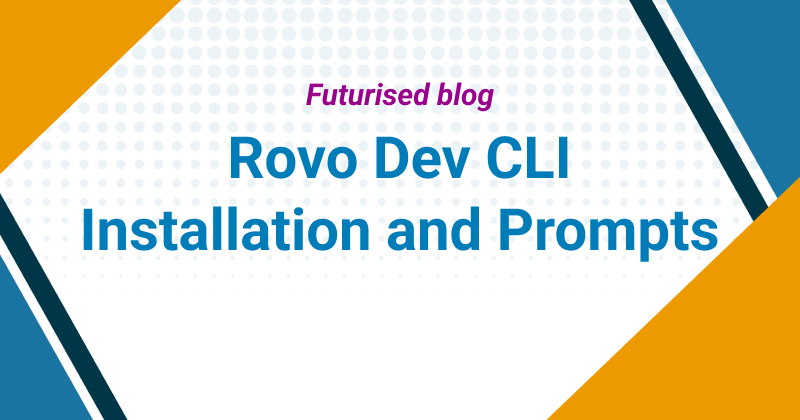Rovo Dev CLI installation and prompts

Use AI to streamline your software development process with Rovo Dev CLI. Perform complex development tasks using natural language – like generating, reviewing, and refactoring code, analysing your codebase, writing documentation, debugging issues, and creating unit tests – without leaving your terminal.
Install Rovo Dev CLI
Open Powershell (change d:\web to your projects folder):
- Invoke-WebRequest -Uri https://acli.atlassian.com/windows/latest/acli_windows_amd64/acli.exe -OutFile D:\web\acli.exe
- TO GET NEW VERSION: delete acli.exe and invoke the download again
Generate an API token from your Atlassian profile (create your own profile).
Open CMD prompt:
- d:\web> acli rovodev auth login
- d:\web> acli rovodev
More details are here: https://futurised.atlassian.net/dev-agents/rovo-dev-cli
Reference https://rovodevagents-beta.atlassian.net/wiki/external/Yzc2NzI4MTk3YTBhNDdiYjkzZDhhZTc3MjE0ZmE4Y2Q
Example prompts
Explore your codebase
Rovo Dev reads your codebase and answers questions in clear language, helping you quickly navigate familiar codebases and decipher new ones.
Explain this repository to me
Where is the authentication logic defined
What input validation happens during user registration?
Work with Atlassian apps
Rovo Dev integrates with Jira and Confluence, so you can access your team’s knowledge and manage your work without switching contexts. Specify the URL of your site in the prompt.
Which Jira work items in site vitafleet.atlassian.net are assigned to me and in To Do status?
Implement code changes for Jira work item ABC-123 in site vitafleet.atlassian.net
Create a list of changes needed to implement dark mode and publish to Confluence in site vitafleet.atlassian.net
Ideate and plan
Rovo Dev analyzes your codebase to help you brainstorm and plan technical solutions.
Suggest new features to add that would improve the user experience
How can I improve performance of this app?
Create a coding plan for adding international currencies to the shopping cart, don't implement any changes yet
Generate code
Rovo Dev generates consistent, structured code to help you build and transform your applications.
Review this modal component and add missing ARIA attributes
Migrate code in this repository from C++ to Java
Add search suggestions to search bar: trigger after 3 characters, include keyboard navigation (up/down/enter), filter on a predefined list of popular products
Analyze and iterate on code
Rovo Dev analyzes code, both existing code and code it has generated, and refines it based on your feedback.
Review this repository and make suggestions to improve readability and performance
I'm getting a 500 error when fetching data from the backend API using Axios - find the issue and fix it
The error handling you generated for this function is too simple - add more specific error cases and retry logic
Write code documentation
Rovo Dev generates documentation based on the latest changes to your codebase.
Write detailed documentation for this REST API, including available endpoints, parameters, and expected responses - publish to Confluence space "Vitafleet"
Write JSDoc-style comments for this JavaScript function that handles form validation
Write a README.md file for this project - include sections "Setup", "Features", and "Deployment information"
Test and deploy
Rovo Dev helps you build comprehensive test suites and configure your deployment pipelines.
Generate 100 rows of synthetic user data with: name, email, age, location, and signup date - output it as a CSV
Write a test using React Testing Library to verify if the form shows appropriate error messages when trying to submit with empty mandatory fields
Modify bitbucket-pipelines.yml to add a step for running Jest tests before deploying
Tips for working with Rovo Dev
Start small – Rovo Dev works best with small changes, about 10 or 20 lines at a time.
Break down your tasks – break bigger changes into smaller steps for Rovo Dev to tackle one at a time.
Review and iterate – treat Rovo Dev like a teammate you’re collaborating with, give feedback on the code it generates with what to change and improve.
Change gears – use the /sessions command to start a new session if the current approach isn’t working and you need a fresh perspective
Save frequently – regularly commit changes to track your progress and avoid losing work if something goes wrong.
Commands
/sessions: Switch between sessions, and view session details.
/prune: Reduce the token size of the current session’s message history while retaining context.
/instructions: Run saved instructions.
/memory: Memory file management.memo
# <note>: Add a note to Rovo Dev’s local memory file.
#! <note>: Remove a note from Rovo Dev’s local memory file.
/usage: Show your daily LLM token usage.
Modes
Interactive mode
Interactive mode is Rovo Dev’s default mode. It lets you use natural language to with the agent so it can answer questions, iterate on code, and problem solve with you.
Run interactive mode from the command line using acli rovodev run.
Non-interactive mode
In non-interactive mode, Rovo Dev updates files in your codebase directly without interaction. This is useful for automating repetitive tasks once you’re happy with results of an instruction.
Run non-interactive mode from the command line using acli rovodev run <instruction>.
For example, you could run acli rovodev run "Create unit tests for all components without tests".
Recent Posts
The Winning SEO Formula for Roofers: Why You Need a Page for Every Service in Every Suburb
Rovo Dev CLI installation and prompts
What is transactional email?
How to Regain Your Lost Top Search Rankings
Microsoft 365 Family Usage
Prompts for Blogs ChatGPT
How Bing Image Creator lets you generate images from words
Free to use images for commercial use
Historical Optimisation: How to Choose the Right Content to Update
AU Direct Registrations and Applications

